|






| |
|
Convergent Mode Sensing |
|

How It Works
Convergent-mode
sensors use reflective energy very efficiently, unlike divergent-mode
sensors. Convergent-mode sensors use a lens system to focus emitter and
the receiver elements to an exact point in front of the sensor. Like
diffuse-mode and divergent-mode sensors, convergent-mode sensors detect
an object when that object completes or
"makes"
the light beam. This design produces a small, intense, and well-defined
sensing area, at a fixed distance from the sensor lens. It is a very
efficient use of reflective energy.
|
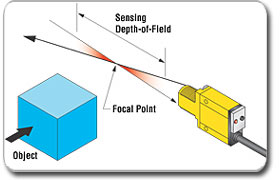 |
|
Pros: High Excess Gain
Convergent-mode
sensors make the most efficient use of reflective sensing energy. This
is a good mode to use to detect objects with low or high reflectivity,
when you canít use an opposed or retroreflective mode sensor. However,
the small beam of the convergent-mode sensor can be easily deflected by
highly specular or shiny surfaces.
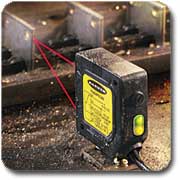
Pros: Counting Radiused Objects
Convergent-mode
sensors allow the sensing light energy to be focused on the nearest
point (i.e. the tangent point) of a radiused object. For this reason, it
is a good choice for counting bottles, jars, or cans, where there is no
space between adjacent products.
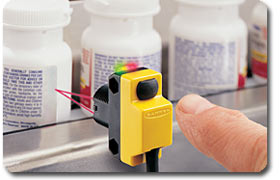
Pros: Accurate Positioning
Convergent-mode
sensors have well-defined effective beams, especially at the focal
point. Therefore it is a good sensing choice, after opposed mode, for
accurately detecting the position of edges. However, convergent-mode
sensing becomes a first choice for accurate position sensing of clear
materials.
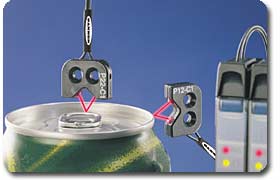
Pros: Fill Level Applications
Convergent-mode
sensors may be used in some applications for detecting the fill level of
materials in an open container, where an ultrasonic sensor would not
work.
Pros: Colour Sensing
Convergent-mode
sensors are available with a wide variety of LED colors such as blue,
green, and red. These sensors work well in colour registration
applications.
|
Cons: Depth of
Field
Convergent-mode
sensors require that the surface to be detected pass at (or close to)
the focal point from the sensor lens.
Avoid the use of
convergent-mode sensors for detection of objects that pass at an
unpredictable distance from the sensor.
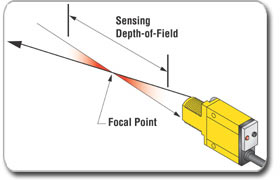
Cons: Effect
of Surface Reflectivity
As with any
photoelectric proximity mode, consider the reflectivity of the surface
to be detected. The distance within which a convergent-mode sensor will
detect an object is relative to that objectís optical reflectivity.
If a shiny background object returns unwanted light, tilt or rotate the
sensor to move the sensing beam so that it is not perpendicular to the
shiny surface.
|
Application -
Ink Jet Printing Registration
Objective:
To sense
the leading edge of bottles and provide the trigger signal to an ink jet
printer.
Bottles are channeled through guide
rails to control the distance to both the sensor and the ink jet
printer. The convergent-mode sensor consistently triggers the printer at
the same point on the circumference of each bottle to provide accurate
printing registration.
|
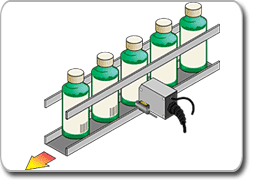 |
Review
The convergent mode makes
very efficient use of reflective energy. It uses a lens to focus its
beam to an exact point, which produces a small, intense and well-defined
sensing area at a fixed distance in front on the sensor. Convergent-mode
sensors are excellent in applications involving accurate positioning,
counting radiused objects, and colour sensing.
Reconsider the use of convergent sensors when the object to be detected
passes by at unpredictable distances, or if the object is very shiny.
|
|